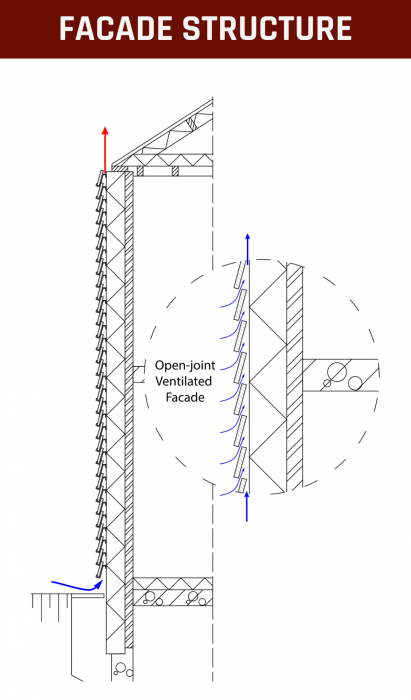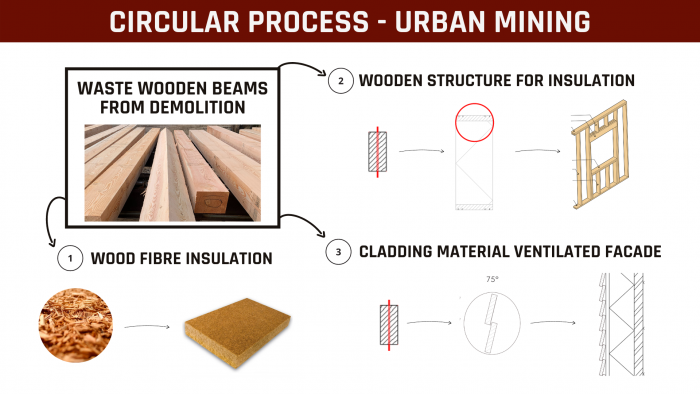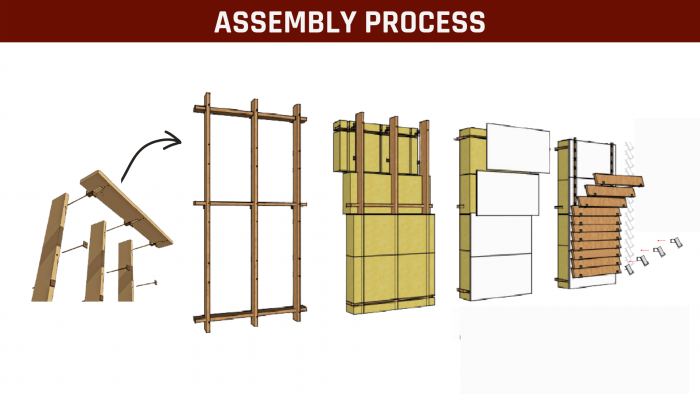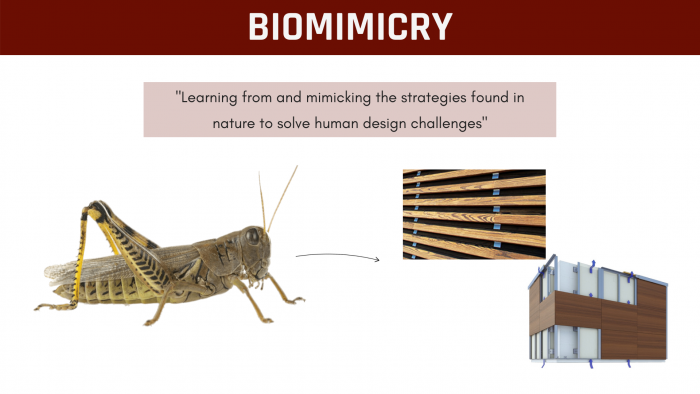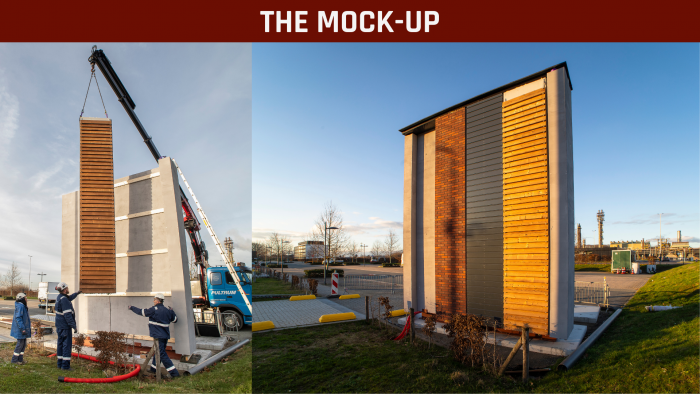This concept combines nature-inspired ideas towards an energy-efficient, circular and reversible built environment, while improving life quality and reducing costs for less privileged families. Therefore, a circular facade was developed by using the respiratory system of crickets as design inspiration and reusing waste materials from demolition. The idea consists of wood fibre insulation and an open-joint ventilated facade with natural air ventilation, covering both summer and winter scenarios.
This project has received funding from the European Union’s H2020 framework programme for research and innovation under grant agreement no 841850.
In face to the current unsustainable scenario within the built environment in the EU, the European Commission have established challenging goals. Therefore, this project drives forces towards reaching out these goals regarding the circular and energy-efficient built environment by developing a facade design and technology, based on three strategies: biomimicry, urban mining and reversibility, which will be further described in the following topics.
First of all, it is essential to mention that the proposal developed was based on a Dutch scenario and weather. The primary goal is to renovate the current energy-inefficient structure of social houses in the Netherlands. Nevertheless, besides making the houses more energy efficient by facade renovation, a completely circular renovation was developed by avoiding extra resources, focusing on reusing waste materials as much as possible, and creating a reversible construction for both maintenance and end-of-life scenarios.
As shown in Fig.1, the proposed facade consists of the original bricklayer, the addition of wood fibre insulation with wooden construction, an air cavity, and an open-joint ventilated facade. All these elements are made from wasted woods from demolition site, in which the circular process is presented in the following topics.
Please highlight how the concept/idea can be exemplary in this context
Several studies have been conducted on buildings' energy efficiency, but they barely cover the material aspects, the energy of product manufacturing, and the reversible and circular design. The circular dimension of this concept covers both the reuse of wood and developing reversible construction.
Firstly, as shown in fig. 2, all the renovation proposal was creatively designed using wasted wood from demolition in three ways:
1. Wood fibre insulation: the wood fibre insulation can be made from the wood waste from demolition, and it is placed between the wooden structure afore the brick wall. An ambitious alternative studied in this project is the production of wood fibre insulation from the sawdust realised during the wooden structure manufacture.
2. Wooden structure: the proposal also includes a structure to support the insulation throughout the facade. Therefore, the wood beams from the demolition will be cut and reused as a structure material for insulation.
3. Cladding material for ventilated facade: the wooden beams will be cut, transformed into slabs, and used as a cladding material for the open-joint ventilated facade.
Secondly, as shown in fig.3, this project developed an easy assembly and disassembly method to guarantee a fast and clean construction. The strategy consists of using a pre-moulded insulation structure with the help of screws. The cladding material for the ventilated facade will be placed using a hook system, avoiding any use of glue or mortar. Thus, the elements have as minor damage as possible and can be again reused in the building's end-of-life.
Finally, trees are an essential carbon sink by filtering CO2 out of the air and absorbing this in its biomass. The longer a wood material remains in the application, the longer the CO2 is removed from the atmosphere. Thus, by employing wood constructions, the concept proposed also presents a solution to extend the lifespan of wood and consequently improve the effectiveness of its carbon storage
Please highlight how the concept/idea can be exemplary in this context
The aesthetics and functionality of the facade concept were developed based on nature-inspired elements. Therefore, using the respiratory system of cricket as inspiration for the facade design and technique, this study proposes improving the energy efficiency and thermal comfort of a common social dwelling typology in the Netherlands.
The respiratory system of the cricket works like this: due to its opening and closing system in their abdominal pores, the cool air enters through its bottom vents, and the air pressure pushes out the hot air through the top vents, and the respiration performs.
The proposed open-joint ventilated facade works similarly. The ventilated facade consists of the previously developed facade, an air cavity, and an additional wooden external skin. The technique of the system works with the cool air entering through the bottom opening and the openings designed throughout the facade high, and the warm air is pushed out through the top opening.
Thus, with the wooden slabs as a cladding material, in which the ventilation performs between the openings, the external aesthetic of the facade brings a rustic appearance into the buildings. With this rustic architecture, the focus is to create a relaxing atmosphere by highlighting the use of wood, and rather than worry about perfect lines, to allow the character of each wooden piece to stand out.
Please highlight how the concept/idea can be exemplary in this context
Energy poverty is an alarming problem in Europe and worldwide, causing deaths and anger at the electricity suppliers' artificial and "absurd pricing structure" to increase profits. Energy poverty refers to a situation where households do not have access or cannot afford the vital energy or energy services to achieve daily living requirements.
Moreover, it is known that the Netherlands has one of the largest social housing sectors in Europe, in which those social houses are mainly meant for people with lower incomes. In this sense, when reducing the energy consumption for heating and cooling proposes by renovating Dutch social houses, this proposal will consequently reduce the energy costs, benefiting this population with lower income. Thus, the proposal could not only contribute to avoiding families struggling with their housing expenses but also combat energy poverty and serve as an inspiration worldwide.
On the other hand, most dwellings in the Netherlands still do not have air conditioner systems, and consequently, the thermal comfort in the houses is becoming a big issue over the years. Therefore, by improving the thermal performance of the dwelling, the proposal also enhances the well being of the inhabitants, which is intimately related to productivity and health.
It is also worth mentioning that with the COVID-19 pandemic, people have been spending much more time inside their homes, and the need for well-thought-out houses are even more evident, both for energy savings, life quality, and productivity.
Please highlight how this approach can be exemplary
The bio-inspired, circular and reversible facade technology and design drive towards a more circular and energy-efficient built environment, bringing a rustic aesthetic into the building and performing a natural ventilation functionality. However, differently from what is expected from most society, this concept shows that constructing energy-efficient houses does not have to be related to investing a higher amount of money.
By reusing wooden waste materials, the renovation costs into a more energy-efficient house can be more affordable for lower-income families. A simple design can bring high energy and money savings throughout the years, promote inclusion, reduce energy poverty, and enhance inhabitants' quality of life. Therefore, the three dimensions (sustainability, inclusion and aesthetic) were the core focus and are directly intertwined in this concept.
The innovative character of this concept relates to the three strategies employed: biomimicry, urban mining, and reversibility.
Nature creates sustainable environments and provides answers to most human challenges since it has evolved for millennia into adequate solutions. Analysing and mimicking natural strategies can bring solutions for several human challenges. That is the idea of biomimicry. We can develop new products and processes with biomimicry and improve existing ones based on nature. These strategies can also be extended to the built environment and bring ample opportunities for innovation in the engineering and architecture design discipline. In this sense, the first innovative character of this concept is the inspiration in the cricket respiratory system to improve building's energy performance.
Secondly, urban mining is a term that represents the process of reusing and recovering the waste materials from urban areas, since most of the materials incorporated into cities are disposed of in landfills, incinerated or downcycled into products of much lower value at the end of its lifespan. Therefore, the proposal focused on developing creative reuse for the wood from demolition from a shirking area in the Netherlands, where several buildings are being demolished. The second innovative character of this concept is the reuse of wood as circular as possible.
The third innovative character of this project is the reversible construction. Reversibility in the built environment challenges the current strategies and processes, minimising the use of primary materials and maximising the rethinking of buildings' shape by employing an easy assembly and disassembly technology for the reuse of materials. Therefore, this project is based on an easy assembly and disassembly method to avoid tenants and neighbourhood disturbance, and guarantee a fast and clean construction by using pre-moulded structures and hook systems, avoiding any use of glue or mortar.
In order to analyse the effectiveness of this concept, a mock-up is being developed (Fig.5). In this mock-up, four facades designs are being tested and compared: a standard facade with double bricklayers, two standard ventilated facades already existent in the market, and the concept developed. Therefore, the concept will be compared with the current structure of social houses in the Netherlands and the energy-efficient facade products already existent in the market.
The mock-up will be tested for one year in natural weather conditions in the Netherlands. Sensors will be placed in the internal bricklayer of each facade type to analyse the temperature difference between them. Furthermore, the circular aspects of reusing wood from demolition are fully considered, and the process will also test the reversibility proposals, such as dry and fast assembly.
The dream of winning the New European Bauhaus Prizes 2022 creates a range of great possibilities to develop my concept and make a difference towards sustainable buildings. Throughout the one and a half years of studies to develop this concept, I have faced several hindrances, mainly due to the lack of building physics specialised professionals in my surroundings. Therefore, if I award this prize, the first step I would trace is to connect with specialised people and discuss the different possibilities to make this concept even more feasible and affordable, aiming at bringing it into the market.
Furthermore, as previously mentioned, this concept was developed based on a common terraced typology dwelling in the Netherlands, which corresponds to approximately 42% of all the dwellings in the country. Therefore, after having the results from the mock-up tests, the importance of this concept relates to the possibility of upscaling the renovation into these dwellings. It would bring significant energy savings and, consequently, a significant reduction in CO2 emission rates.
Moreover, throughout the computational simulations, I have concluded that there is a high possibility of bringing even better energy efficiency results if expanding this design into different countries and warmer weathers. Therefore, getting awarded this prize would open my opportunities to test and bring it into warmer and less privileged countries and assist both the rethinking of waste materials and the thermal comfort of buildings.
@Bitar, 2022
Content licensed to the European Union.
